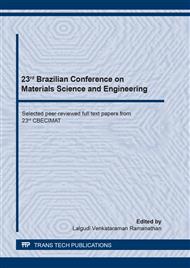p.125
p.131
p.136
p.141
p.147
p.153
p.158
p.167
p.173
Influence of the Electrolyte Potential Window on the Electrical Characteristics of Supercapacitors Operating Elevated Temperatures
Abstract:
The equivalent series resistances (ESR) and specific capacitances (Cs) of supercapacitors carbon electrodes have been investigated using cyclic voltammetry and electrochemical impedance spectroscopy. Commercial activated carbon electrodes employing organic electrolyte have been tested using a potential window in the range of 2.7–3.8 V. Specific capacitances were calculated from cyclic voltammetry curves at room temperature employing various scan rates (30 and 100mVs-1). Internal series resistances of the supercapacitors were measured using the galvanostatic curves at room temperature and above (25 and 50°C). The ESR increase to 9.8 Ω at 25° and 2.7V to 78.8 Ω at with operating temperature raise and also with overpotential. A compositional and morphological evaluation of these electrodes showed a very homogeneous structure. It has been shown that the specific capacitance decreased considerably with scan rate, current density, electrochemical potential window and working temperature.
Info:
Periodical:
Pages:
147-152
Citation:
Online since:
October 2020
Authors:
Price:
Сopyright:
© 2020 Trans Tech Publications Ltd. All Rights Reserved
Share:
Citation:


